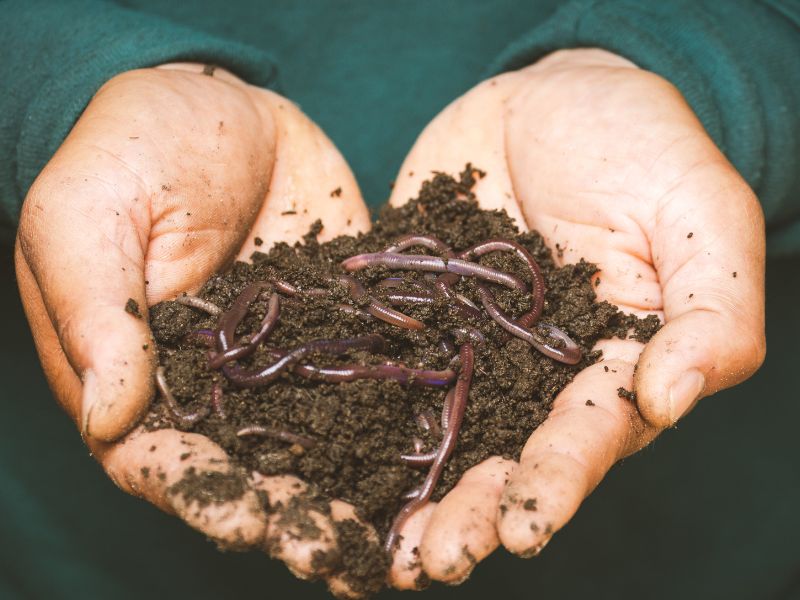The Ultimate Red Wiggler Composting Checklist for Effective Vermiculture
The Ultimate Red Wiggler Composting Checklist for Effective Vermiculture
Blog Article
Checking Out the Devices of Red Wiggler Composting: A Comprehensive Overview to the Process and Its Favorable Effect On Lasting Horticulture Practices
The detailed systems of red wiggler composting, making use of the unique physiology of Eisenia fetida, provide an engaging avenue for enhancing lasting gardening practices. As metropolitan horticulture gains traction, recognizing the nuances of this composting technique becomes increasingly appropriate.
Understanding Red Wigglers
Red wigglers, medically referred to as Eisenia fetida, are a varieties of earthworm highly pertained to for their effectiveness in composting organic waste. These worms grow in nutrient-rich atmospheres, specifically in decaying natural matter, making them ideal for vermicomposting systems - Red Wiggler Composting. Defined by their reddish-brown pigmentation and fractional bodies, red wigglers are smaller than typical earthworms, typically determining in between three to four inches in length
Their unique physiological attributes enhance their composting capacities; for example, they possess a high reproductive rate, permitting populations to increase swiftly under suitable conditions. Red wigglers take in natural product, simplifying via their gastrointestinal systems, which results in nutrient-rich castings that act as an exceptional natural fertilizer. Their voracious appetite allows them to process large volumes of food waste efficiently, considerably minimizing garbage dump contributions.
In enhancement to their composting prowess, red wigglers play a crucial duty in dirt health. Red Wiggler Composting. They aerate the soil and assist in the decomposition of organic issue, further enhancing the soil ecosystem. Recognizing the qualities and environmental benefits of red wigglers is essential for anyone aiming to apply sustainable gardening techniques via reliable composting methods
The Composting Refine
The composting process involves breaking down organic materials into nutrient-rich compost, a task that red wigglers excel at because of their specialized digestive systems. These worms eat food scraps, yard waste, and various other organic matter, transforming them right into valuable compost with a collection of organic and chemical procedures.
Originally, the raw material is combined with bedding materials such as shredded paper or dried out fallen leaves, creating an optimal setting for the worms. As the red wigglers consume this mixture, they simplify via their digestive tract, where microbes additionally disintegrate the product. This process generates heat, promoting microbial activity, which speeds up disintegration.

Advantages of Red Wiggler Composting
Eco-conscious people and several gardeners identify the many benefits of red wiggler composting, making it a prominent option for effective waste monitoring. One of the primary benefits is its capability to significantly minimize natural waste in land fills - Red Wiggler Composting. Red wigglers effectively damage down kitchen scraps and other biodegradable products, changing them into nutrient-rich vermicompost that enhances soil health and wellness
In addition, red wiggler composting enhances dirt framework and fertility. The resulting vermicompost is including advantageous microbes, which promote plant development and enhance nutrient retention. This all-natural plant food not only supports sustainable gardening methods but also minimizes dependence on chemical fertilizers, promoting a healthier ecosystem.
Furthermore, red wiggler composting is a space-efficient approach, making it optimal for metropolitan garden enthusiasts with limited room. The process can be conducted indoors or outdoors, enabling year-round composting no matter environment problems. Red wigglers are low-maintenance microorganisms that require marginal treatment, making them available for novice gardeners.
Fundamentally, the advantages of red wiggler composting expand beyond waste reduction; they add to healthier soils, lasting gardening methods, and environmental stewardship, positioning it as a valuable technique in modern-day cultivation.
Best Practices for Composting
For successful red wiggler composting, adhering to ideal practices is vital to make the most of performance and make certain an efficient environment for these worms. This balance promotes optimum decomposition and boosts the worms' health and wellness.
Following, monitor wetness levels, going for a wet, sponge-like consistency. Overly wet conditions can bring about anaerobic decomposition, while extreme dryness may prevent worm task. Additionally, guarantee proper oygenation by turning the compost on a regular basis, which assists avoid compaction and allows for sufficient oxygen flow.
Temperature level is an additional essential element. Maintain a variety of 55 ° F to 77 ° F(13 ° C to 25 ° C) to advertise worm task and microbial growth. Ultimately, prevent presenting meat, dairy, and oily foods, as these can bring in pests and produce odors.
Enhancing Sustainable Horticulture
Lasting horticulture personifies a holistic method that balances ecological principles with useful gardening techniques. By including techniques such as red wiggler composting, gardeners can substantially boost their methods, cultivating a more resistant environment. Red wigglers, renowned for their effective decomposition capabilities, convert organic waste into nutrient-rich garden compost, thereby improving the soil without depending on chemical fertilizers.
Executing sustainable gardening methods, such as plant turning, friend planting, and mulching, further complements the benefits of composting. These practices not just boost Continue soil structure and fertility but likewise promote biodiversity, attracting useful insects and organisms that add to grow wellness. Using native plants can reduce water intake and reduce upkeep, aligning with water conservation initiatives.

Verdict
In conclusion, red wiggler composting stands for an essential approach for improving lasting gardening practices. Inevitably, the fostering of red wiggler composting can dramatically add to environmentally friendly gardening, benefitting both urban and amateur gardeners in their farming efforts.
The detailed systems of great site red wiggler composting, using the special physiology of Eisenia fetida, offer an engaging method for boosting sustainable gardening practices. Understanding the features and ecological advantages of red wigglers is necessary for anyone looking to apply lasting horticulture practices with reliable composting useful link techniques.

In verdict, red wiggler composting represents a crucial technique for improving sustainable horticulture methods. Inevitably, the fostering of red wiggler composting can considerably add to environmentally friendly gardening, profiting both city and beginner gardeners in their growing initiatives.
Report this page